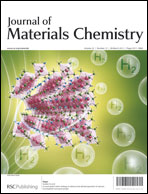Rational design and engineering of materials and/or structures for novel electrodes leading to next-generation lithium-ion batteries with high energy and power densities is a major challenge to the ever-growing needs of the electronic and automobile industries. To tackle this issue, we have designed a new type of 3D anode by anodization of iron foil to form a highly ordered Fe3O4 nanotube array directly on a low-cost current collector (Fe foil) followed by carbonization of pre-adsorbed glucose on the nanotube array at 500 °C. In such an electrode, each part plays its desired role, with the Fe foil being a low cost and stable current collector, Fe3O4 working as a high-capacity active material, and the carbon coating forming an electron conducting network and stable solid electrolyte interface. High capacity (1020 μA h cm−2 at 20 μA cm−2) and high rate capability (176 μA h cm−2 at 1000 μA cm−2) were achieved in this newly designed electrode. Overall, the results described in this work provide a promising route to facile and large-scale production of a low-cost 3D composite electrode with enhanced electrochemical performance.

You have access to this article
 Please wait while we load your content...
Something went wrong. Try again?
Please wait while we load your content...
Something went wrong. Try again?


 Please wait while we load your content...
Please wait while we load your content...